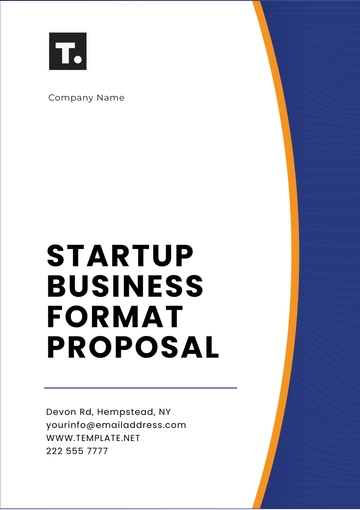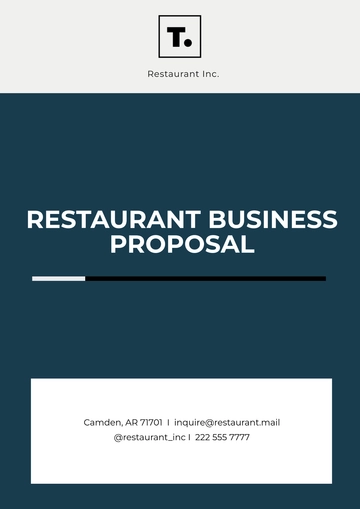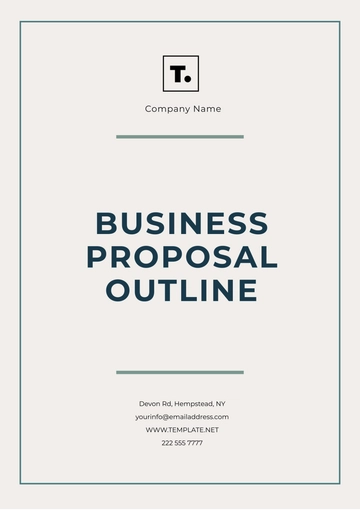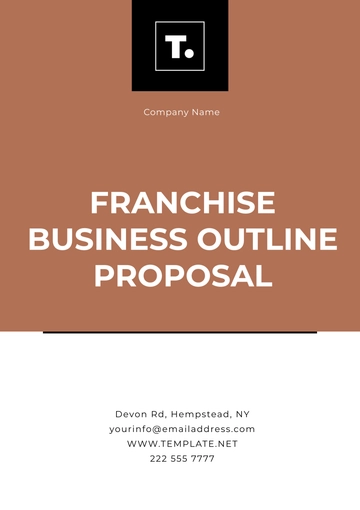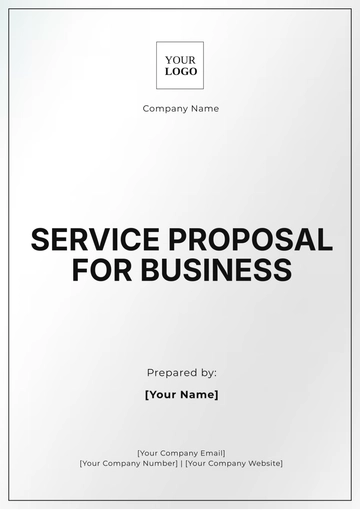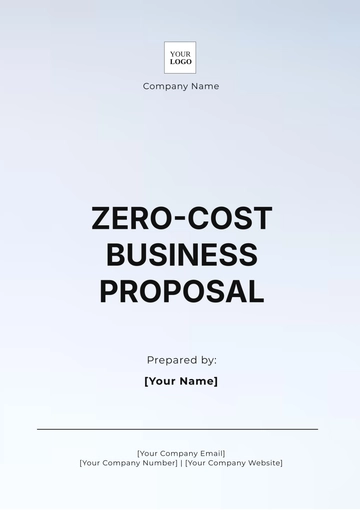Free Agriculture New Market Entry Proposal

Introduction
Expanding into new markets presents a significant opportunity for agricultural businesses to grow and diversify their revenue streams. Entering a new market requires careful planning, research, and execution to ensure success. This comprehensive proposal outlines the strategy and steps necessary for [Your Company Name] to enter a new market effectively. It includes market analysis, entry strategy, marketing plan, operational plan, financial projections, and risk management.
1. Market Analysis
Understanding the target market is crucial for successful entry. This section provides an in-depth analysis of the selected market, including demand, competition, and regulatory environment.
1.1 Market Overview
Objective: To provide a general overview of the target market.
Analysis:
Market Size: The target market has a potential customer base of 2 million and an annual revenue of $500 million.
Growth Rate: The market is growing at a rate of 7% annually.
Key Players: Major competitors include Competitor A, Competitor B, and Competitor C.
1.2 Customer Analysis
Objective: To understand the needs and preferences of potential customers.
Data Analysis:
Demographics: The primary customer base consists of individuals aged 25-50, predominantly from urban areas with a middle to high-income level.
Preferences: Customers in this market prefer organic and sustainably sourced agricultural products.
Buying Behavior: Typical buying patterns include frequent purchases from local markets and online platforms, with a preference for quality over price.
1.3 Competitive Analysis
Objective: To assess the competitive landscape.
Data Analysis:
Competitor Strengths:
Competitor A has strong brand recognition.
Competitor B offers competitive pricing.
Competitor C has a wide distribution network.
Competitor Weaknesses:
Competitor A has limited product variety.
Competitor B has low customer loyalty.
Competitor C has higher prices.
Table: Competitive Analysis
Competitor | Strengths | Weaknesses |
|---|---|---|
Competitor A | Strong brand recognition | Limited product variety |
Competitor B | Competitive pricing | Low customer loyalty |
Competitor C | Wide distribution network | Higher prices |
1.4 Regulatory Environment
Objective: To understand the regulatory requirements for entering the market.
Analysis:
Import Regulations: The target market has specific regulations for importing agricultural products, including tariffs and quotas.
Certification Requirements: Products must meet organic certification standards to be sold in the market.
Compliance: Compliance with local labor, safety, and environmental regulations is mandatory.
2. Market Entry Strategy
A well-defined market entry strategy is essential for successful market penetration. This section outlines the approach for entering the new market, including entry mode, partnerships, and timeline.
2.1 Entry Mode
Objective: To select the most appropriate mode of entry.
Options:
Direct Exporting: Exporting products directly to distributors or retailers in the target market.
Joint Ventures: Partnering with a local company to leverage their market knowledge and distribution network.
Franchising: Granting rights to local operators to sell our products under our brand.
2.2 Partnership Development
Objective: To establish strategic partnerships to facilitate market entry.
Steps:
Identify Potential Partners:
Research and shortlist potential partners based on their market presence, reputation, and alignment with our business goals.
Due Diligence:
Conduct thorough due diligence on potential partners to assess their financial stability, operational capabilities, and compliance with local regulations.
Negotiation and Agreement:
Negotiate terms and conditions, and formalize partnerships through contracts and agreements.
Table: Potential Partners
Partner | Strengths | Alignment with Goals |
|---|---|---|
Partner A | Extensive distribution network | High |
Partner B | Strong local market knowledge | Medium |
Partner C | Established relationships with retailers | High |
2.3 Timeline and Milestones
Objective: To outline the key milestones and timeline for market entry.
Steps:
Preparation Phase (Month 1-3):
Conduct market research, finalize entry strategy, and identify partners.
Implementation Phase (Month 4-6):
Establish partnerships, set up distribution channels, and begin marketing activities.
Launch Phase (Month 7-9):
Launch products in the market, monitor initial sales, and adjust strategies as needed.
Evaluation Phase (Month 10-12):
Evaluate performance, gather feedback, and refine the approach for sustained growth.
Table: Market Entry Timeline
Phase | Activities | Timeline |
|---|---|---|
Preparation Phase | Market research, strategy finalization | Month 1-3 |
Implementation Phase | Establish partnerships, set up distribution | Month 4-6 |
Launch Phase | Product launch, monitor sales | Month 7-9 |
Evaluation Phase | Performance evaluation, strategy refinement | Month 10-12 |
3. Marketing Plan
An effective marketing plan is essential for building brand awareness and driving sales in the new market. This section outlines the marketing strategies and activities to be implemented.
3.1 Marketing Objectives
Objective: To establish clear and measurable marketing objectives.
Goals:
Brand Awareness: Achieve 30% brand awareness within the first year.
Market Penetration: Capture 10% market share within two years.
Sales Targets: Generate $2,000,000 in sales revenue within the first year.
3.2 Marketing Strategies
Objective: To develop strategies for reaching and engaging the target audience.
Strategies:
Digital Marketing:
Utilize social media, search engine optimization (SEO), and online advertising to reach potential customers.
Create engaging content that highlights the benefits and unique features of our products.
Traditional Marketing:
Implement print advertising, direct mail campaigns, and participation in local trade shows and events.
Develop relationships with local media for press coverage and product reviews.
In-Store Promotions:
Partner with retailers to offer in-store promotions, discounts, and product demonstrations.
Provide point-of-sale materials such as brochures and displays to educate customers.
Table: Marketing Strategies
Strategy | Activities | Timeline |
|---|---|---|
Digital Marketing | Social media campaigns, SEO, online ads | Ongoing |
Traditional Marketing | Print ads, direct mail, trade show participation | Month 4-6 |
In-Store Promotions | Promotions, discounts, product demos | Month 7-9 |
3.3 Marketing Budget
Objective: To allocate resources effectively to achieve marketing objectives.
Budget Allocation:
Digital Marketing: $100,000
Traditional Marketing: $75,000
In-Store Promotions: $50,000
Contingency Fund: $25,000
Table: Marketing Budget
Category | Budget ($) | Percentage of Total |
|---|---|---|
Digital Marketing | 100,000 | 40% |
Traditional Marketing | 75,000 | 30% |
In-Store Promotions | 50,000 | 20% |
Contingency Fund | 25,000 | 10% |
Total | 250,000 | 100% |
3.4 Performance Metrics
Objective: To measure the effectiveness of marketing activities.
Metrics:
Brand Awareness: Track through surveys and social media metrics.
Market Share: Monitor through sales data and market research.
Sales Revenue: Analyze through financial reports and sales tracking systems.
Table: Performance Metrics
Metric | Target | Measurement Method |
|---|---|---|
Brand Awareness | 30% awareness within the first year | Surveys, social media |
Market Share | 10% market share within two years | Sales data, market research |
Sales Revenue | $2,000,000 in first-year revenue | Financial reports |
4. Operational Plan
Efficient operations are critical for delivering products to the new market effectively. This section outlines the operational plan, including supply chain management, production planning, and quality control.
4.1 Supply Chain Management
Objective: To ensure a reliable and efficient supply chain for delivering products to the new market.
Steps:
Supplier Selection:
Identify and select suppliers that meet quality and reliability standards.
Logistics Planning:
Develop a logistics plan for transportation, warehousing, and distribution.
Inventory Management:
Implement inventory management systems to ensure optimal stock levels.
Table: Supply Chain Plan
Activity | Description | Timeline |
|---|---|---|
Supplier Selection | Identify and contract with reliable suppliers | Month 1-3 |
Logistics Planning | Develop transportation and warehousing plan | Month 4-6 |
Inventory Management | Implement inventory tracking systems | Month 7-9 |
4.2 Production Planning
Objective: To ensure consistent and high-quality production to meet market demand.
Steps:
Capacity Planning:
Assess current production capacity and identify any gaps.
Plan for additional resources or shifts as needed.
Production Scheduling:
Develop production schedules to meet demand forecasts.
Monitor production progress and adjust schedules as needed.
Quality Control:
Implement quality control measures to ensure product consistency and compliance with standards.
Table: Production Plan
Activity | Description | Timeline |
|---|---|---|
Capacity Planning | Assess and plan for additional resources | Month 1-3 |
Production Scheduling | Develop and monitor production schedules | Month 4-6 |
Quality Control | Implement and monitor quality control measures | Ongoing |
4.3 Distribution and Logistics
Objective: To ensure efficient distribution and logistics for timely delivery of products.
Steps:
Distribution Network:
Establish a distribution network in the target market.
Partner with local distributors and retailers.
Logistics Management:
Develop logistics plans for transportation and warehousing.
Implement tracking systems for real-time monitoring of shipments.
Customer Service:
Set up customer service operations to handle inquiries, orders, and returns.
Table: Distribution and Logistics Plan
Activity | Description | Timeline |
|---|---|---|
Distribution Network | Establish partnerships with local distributors and retailers | Month 1-3 |
Logistics Management | Develop transportation and warehousing plans | Month 4-6 |
Customer Service | Set up customer service operations | Month 7-9 |
5. Financial Projections
Accurate financial projections are essential for planning and securing funding for market entry. This section provides detailed financial forecasts for the first three years of operations.
5.1 Revenue Projections
Objective: To forecast revenue based on market analysis and sales targets.
Assumptions:
Market Share: Achieve 10% market share in the first year, growing to 20% in the third year.
Pricing: Average selling price of $40 per unit.
Table: Revenue Projections
Year | Units Sold | Revenue ($) |
|---|---|---|
Year 1 | 50,000 | 2,000,000 |
Year 2 | 75,000 | 3,000,000 |
Year 3 | 100,000 | 4,000,000 |
5.2 Expense Projections
Objective: To forecast expenses based on operational plans and marketing strategies.
Assumptions:
Production Costs: $20 per unit.
Marketing Costs: $250,000 annually.
Logistics Costs: $200,000 annually.
Table: Expense Projections
Year | Production Costs ($) | Marketing Costs ($) | Logistics Costs ($) | Total Expenses ($) |
|---|---|---|---|---|
Year 1 | 1,000,000 | 250,000 | 200,000 | 1,450,000 |
Year 2 | 1,500,000 | 250,000 | 200,000 | 1,950,000 |
Year 3 | 2,000,000 | 250,000 | 200,000 | 2,450,000 |
5.3 Profit and Loss Projections
Objective: To forecast profitability based on revenue and expense projections.
Assumptions:
Revenue and Expenses: Based on the above projections.
Net Profit Margin: Expected to be 10% in the first year, increasing to 20% in the third year.
Table: Profit and Loss Projections
Year | Revenue ($) | Total Expenses ($) | Net Profit ($) |
|---|---|---|---|
Year 1 | 2,000,000 | 1,450,000 | 550,000 |
Year 2 | 3,000,000 | 1,950,000 | 1,050,000 |
Year 3 | 4,000,000 | 2,450,000 | 1,550,000 |
5.4 Break-Even Analysis
Objective: To determine the break-even point for the new market entry.
Assumptions:
Fixed Costs: $500,000 annually.
Variable Costs: $20 per unit.
Table: Break-Even Analysis
Year | Fixed Costs ($) | Variable Costs ($) | Break-Even Point (Units) |
|---|---|---|---|
Year 1 | 500,000 | 20 | 25,000 |
Year 2 | 500,000 | 20 | 25,000 |
Year 3 | 500,000 | 20 | 25,000 |
6. Risk Management
Identifying and mitigating risks is crucial for the successful entry into a new market. This section outlines potential risks and mitigation strategies.
6.1 Market Risks
Objective: To identify and mitigate risks associated with market conditions.
Risks:
Economic Instability: Potential impact on consumer purchasing power.
Competitive Pressure: Aggressive competition from established players.
Mitigation Strategies:
Economic Instability: Diversify product offerings and target different customer segments.
Competitive Pressure: Differentiate products through quality, innovation, and customer service.
6.2 Operational Risks
Objective: To identify and mitigate risks associated with operational activities.
Risks:
Supply Chain Disruptions: Potential delays or interruptions in the supply chain.
Quality Control Issues: Risk of product quality not meeting standards.
Mitigation Strategies:
Supply Chain Disruptions: Establish multiple suppliers and develop contingency plans.
Quality Control Issues: Implement strict quality control measures and regular inspections.
6.3 Financial Risks
Objective: To identify and mitigate financial risks.
Risks:
Currency Fluctuations: Impact on profitability due to exchange rate changes.
Funding Shortfalls: Insufficient funds to support market entry activities.
Mitigation Strategies:
Currency Fluctuations: Use hedging strategies to manage exchange rate risk.
Funding Shortfalls: Secure multiple funding sources and maintain a contingency fund.
6.4 Compliance Risks
Objective: To identify and mitigate risks associated with regulatory compliance.
Risks:
Regulatory Changes: Potential changes in import/export regulations.
Non-Compliance: Risk of non-compliance with local laws and regulations.
Mitigation Strategies:
Regulatory Changes: Stay informed about regulatory developments and adjust strategies accordingly.
Non-Compliance: Implement robust compliance programs and conduct regular audits.
Table: Risk Management Plan
Risk | Impact | Likelihood | Mitigation Strategy |
|---|---|---|---|
Economic Instability | High | Medium | Diversify product offerings |
Competitive Pressure | Medium | High | Differentiate products |
Supply Chain Disruptions | High | Medium | Multiple suppliers, contingency plans |
Quality Control Issues | Medium | Low | Strict quality control measures |
Currency Fluctuations | High | High | Hedging strategies |
Funding Shortfalls | High | Low | Secure multiple funding sources |
Regulatory Changes | Medium | Medium | Stay informed, adjust strategies |
Non-Compliance | High | Low | Robust compliance programs, regular audits |
Conclusion
Entering a new market requires careful planning and execution. This comprehensive proposal outlines the strategy and steps necessary for [Your Company Name] to successfully enter and thrive in a new market. By leveraging market research, developing a robust market entry strategy, implementing effective marketing and operational plans, and managing financial and operational risks, we can achieve sustained growth and profitability.
Prepared by:
[Your Name]
[Your Title]
[Your Company Name]
[Your Company Email]
- 100% Customizable, free editor
- Access 1 Million+ Templates, photo’s & graphics
- Download or share as a template
- Click and replace photos, graphics, text, backgrounds
- Resize, crop, AI write & more
- Access advanced editor
Explore new horizons with Template.net's Agriculture New Market Entry Proposal Template. Designed to be fully editable and customizable using our AI editor, this template equips agricultural enterprises with a strategic framework for entering new markets. Streamline your approach to market analysis, entry strategies, and potential partnerships to capitalize on emerging opportunities effectively.
You may also like
- Business Proposal
- Research Proposal
- Proposal Request
- Project Proposal
- Grant Proposal
- Photography Proposal
- Job Proposal
- Budget Proposal
- Marketing Proposal
- Branding Proposal
- Advertising Proposal
- Sales Proposal
- Startup Proposal
- Event Proposal
- Creative Proposal
- Restaurant Proposal
- Blank Proposal
- One Page Proposal
- Proposal Report
- IT Proposal
- Non Profit Proposal
- Training Proposal
- Construction Proposal
- School Proposal
- Cleaning Proposal
- Contract Proposal
- HR Proposal
- Travel Agency Proposal
- Small Business Proposal
- Investment Proposal
- Bid Proposal
- Retail Business Proposal
- Sponsorship Proposal
- Academic Proposal
- Partnership Proposal
- Work Proposal
- Agency Proposal
- University Proposal
- Accounting Proposal
- Real Estate Proposal
- Hotel Proposal
- Product Proposal
- Advertising Agency Proposal
- Development Proposal
- Loan Proposal
- Website Proposal
- Nursing Home Proposal
- Financial Proposal
- Salon Proposal
- Freelancer Proposal
- Funding Proposal
- Work from Home Proposal
- Company Proposal
- Consulting Proposal
- Educational Proposal
- Construction Bid Proposal
- Interior Design Proposal
- New Product Proposal
- Sports Proposal
- Corporate Proposal
- Food Proposal
- Property Proposal
- Maintenance Proposal
- Purchase Proposal
- Rental Proposal
- Recruitment Proposal
- Social Media Proposal
- Travel Proposal
- Trip Proposal
- Software Proposal
- Conference Proposal
- Graphic Design Proposal
- Law Firm Proposal
- Medical Proposal
- Music Proposal
- Pricing Proposal
- SEO Proposal
- Strategy Proposal
- Technical Proposal
- Coaching Proposal
- Ecommerce Proposal
- Fundraising Proposal
- Landscaping Proposal
- Charity Proposal
- Contractor Proposal
- Exhibition Proposal
- Art Proposal
- Mobile Proposal
- Equipment Proposal
- Student Proposal
- Engineering Proposal
- Business Proposal








